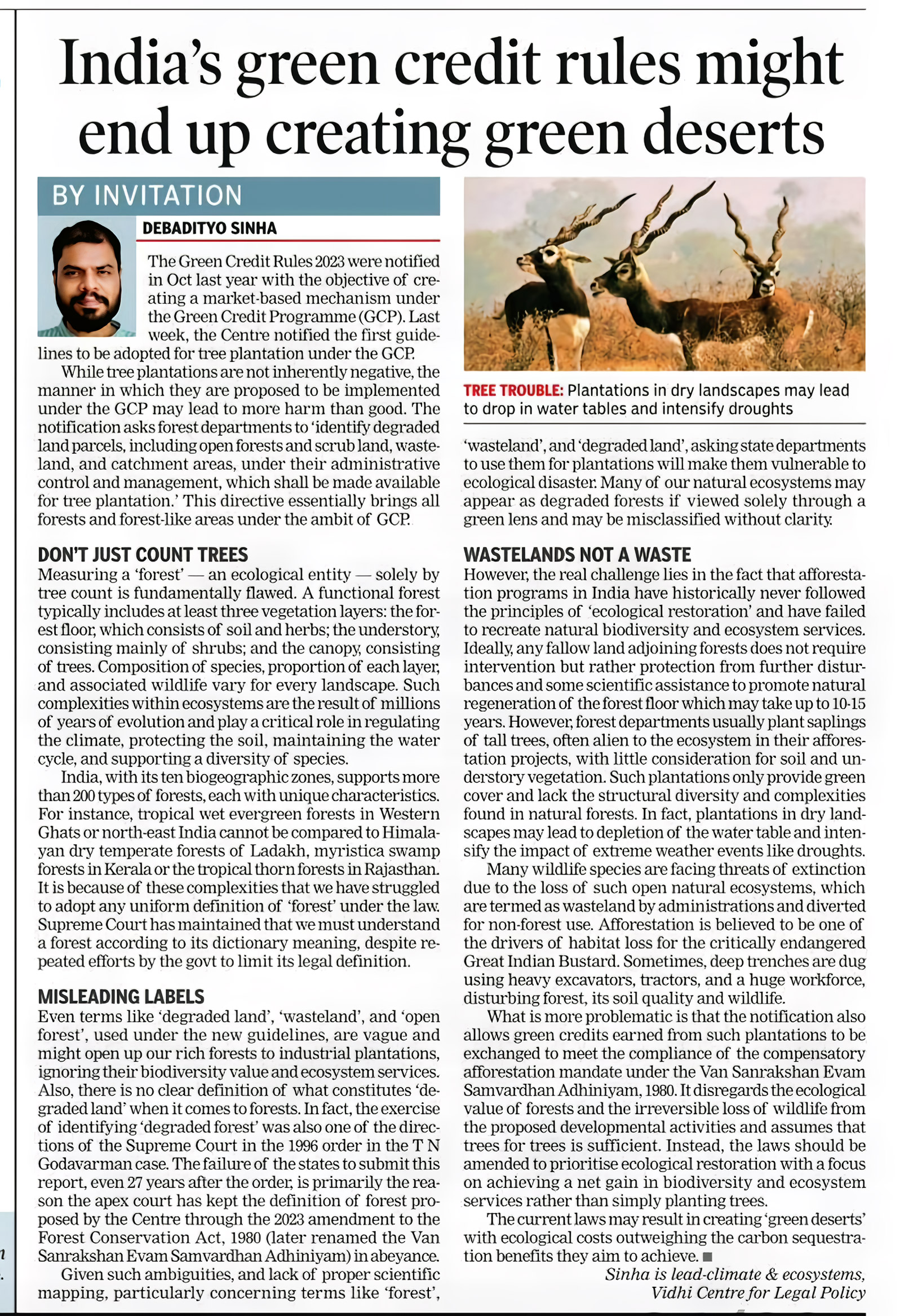The Green Credit Rules 2023 were notified in Oct last year with the objective of creating a market-based mechanism under the Green Credit Programme (GCP). Last week, the Centre notified the first guidelines to be adopted for tree plantation under the GCP.
While tree plantations are not inherently negative, the manner in which they are proposed to be implemented under the GCP may lead to more harm than good. The notification asks forest departments to ‘identify degraded land parcels, including open forests and scrub land, wasteland, and catchment areas, under their administrative control and management, which shall be made available for tree plantation.’ This directive essentially brings all forests and forest-like areas under the ambit of GCP.
DON’T JUST COUNT TREES
Measuring a ‘forest’ — an ecological entity — solely by tree count is fundamentally flawed. A functional forest typically includes at least three vegetation layers: the forest floor, which consists of soil and herbs; the understory, consisting mainly of shrubs; and the canopy, consisting of trees. Composition of species, proportion of each layer, and associated wildlife vary for every landscape. Such complexities within ecosystems are the result of millions of years of evolution and play a critical role in regulating the climate, protecting the soil, maintaining the water cycle, and supporting a diversity of species.
India, with its ten biogeographic zones, supports more than 200 types of forests, each with unique characteristics which overlap beyond the political boundaries of states. For instance, tropical wet evergreen forests in Western Ghats or north-east India cannot be compared to Himalayan dry temperate forests of Ladakh or myristica swamp forests in Kerala or the tropical thorn forests in Rajasthan. It is because of these ecological complexities that we have struggled to adopt any uniform definition of ‘forest’ under the law. The Supreme Court has maintained that we must understand a forest according to its dictionary meaning, despite repeated efforts by the government to limit the legal definition of the term.
MISLEADING LABELS
Even terms like ‘degraded land’, ‘wasteland’, and ‘open forest’, used under the new guidelines, are vague and might open up our rich forests to industrial plantations, ignoring their biodiversity value and ecosystem services. Also, there is no clear definition of what constitutes ‘degraded land’ when it comes to forests. In fact, the exercise of identifying ‘degraded forest’ was also one of the directions of the Supreme Court in the 1996 order in the T N Godavarman case. The failure of the states to submit this report, even 27 years after the order, is primarily the reason the apex court has kept the definition of forest proposed by the Centre through the 2023 amendment to the Forest Conservation Act, 1980 (later renamed the Van Sanrakshan Evam Samvardhan Adhiniyam) in abeyance.
Given such ambiguities, and lack of proper scientific mapping, particularly concerning terms like ‘forest’, ‘wasteland’, and ‘degraded land’, asking state departments to use them for plantations will make them vulnerable to ecological disaster. Many of our natural ecosystems may appear as degraded forests if viewed solely through a green lens and may be misclassified without clarity.
WASTELANDS NOT A WASTE
However, the real challenge lies in the fact that afforestation programs in India have historically never followed the principles of ‘ecological restoration’ and have failed to recreate natural biodiversity and ecosystem services. Ideally, any fallow land adjoining forests does not require intervention but rather protection from further disturbances and some scientific assistance to promote the natural regeneration of the forest floor. Such a process may take up to 10-15 years. However, forest departments usually plant saplings of tall trees, often alien to the ecosystem in their afforestation projects, with little consideration for soil and understory vegetation. Such plantations only provide green cover and lack the structural diversity and complexities found in natural forests. In fact, plantations in dry landscapes may lead to depletion of the water table and intensify the impact of extreme weather events like droughts.
Many wildlife species are facing threats of extinction due to the loss of such open natural ecosystems, which are termed as wasteland by administrations and diverted for non-forest use. Afforestation is believed to be one of the drivers of habitat loss for the critically endangered Great Indian Bustard. Sometimes, deep trenches are dug using heavy excavators, tractors, and a huge workforce, disturbing not only the forest and its soil quality but also proving fatal for wildlife.
What is more problematic is that the notification also allows green credits earned from such plantations to be exchanged to meet the compliance of the compensatory afforestation mandate under the Van Sanrakshan Evam Samvardhan Adhiniyam, 1980. It disregards the ecological value of forests and the irreversible loss of wildlife from the proposed developmental activities and assumes that trees for trees is sufficient. Instead, the laws should be amended to prioritise ecological restoration with a focus on achieving a net gain in biodiversity and ecosystem services rather than simply planting trees.
The current laws may result in creating ‘green deserts’ with ecological costs outweighing the carbon sequestration benefits they aim to achieve.
Debadityo Sinha is a conservationist and lead-climate & ecosystems, Vidhi Centre for Legal Policy
The article appeared in The Sunday Times of India, print edition on 3rd March ’24 and can be also accessed online here.


